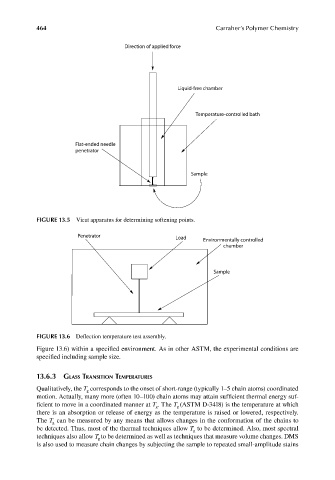Page 501 - Carrahers_Polymer_Chemistry,_Eighth_Edition
P. 501
464 Carraher’s Polymer Chemistry
Direction of applied force
Liquid-free chamber
Temperature-controlled bath
Flat-ended needle
penetrator
Sample
FIGURE 13.5 Vicat apparatus for determining softening points.
Penetrator Load Environmentally controlled
chamber
Sample
FIGURE 13.6 Deflection temperature test assembly.
Figure 13.6) within a specified environment. As in other ASTM, the experimental conditions are
specified including sample size.
13.6.3 GLASS TRANSITION TEMPERATURES
Qualitatively, the T corresponds to the onset of short-range (typically 1–5 chain atoms) coordinated
g
motion. Actually, many more (often 10–100) chain atoms may attain sufficient thermal energy suf-
ficient to move in a coordinated manner at T . The T (ASTM D-3418) is the temperature at which
g
g
there is an absorption or release of energy as the temperature is raised or lowered, respectively.
The T can be measured by any means that allows changes in the conformation of the chains to
g
be detected. Thus, most of the thermal techniques allow T to be determined. Also, most spectral
g
techniques also allow T to be determined as well as techniques that measure volume changes. DMS
g
is also used to measure chain changes by subjecting the sample to repeated small-amplitude stains
9/14/2010 3:42:16 PM
K10478.indb 464 9/14/2010 3:42:16 PM
K10478.indb 464

